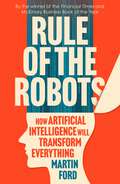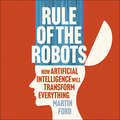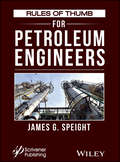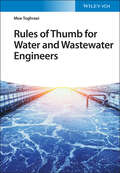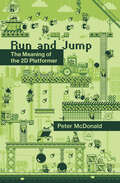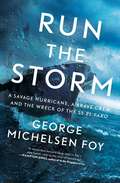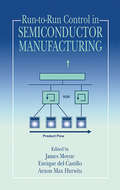- Table View
- List View
Rule of the Robots: How Artificial Intelligence Will Transform Everything
by Martin FordIn this sequel to his prescient New York Times bestseller Rise of the Robots, Martin Ford presents us with a striking vision of the very near future. He argues that AI is a uniquely powerful technology, a kind of "electricity of intelligence" that is altering every dimension of human life, often for the better with advanced science being done by machines who can solve problems humans can not. AI has the potential to help us fight climate change or the next pandemic, but it also has a capacity for profound harm. Deep fakes-AI-generated audio or video of events that never happened-are poised to cause havoc throughout society. AI empowers authoritarian regimes like China with unprecedented mechanisms for social control. And AI can be deeply biased, learning bigoted attitudes from the data used to train algorithms and perpetuating them. Hard-hitting and thought-provoking, covering everything from self-driving cars to the history of deep learning to apps for diagnosing skin cancer, Rule of the Robots challenges our fears and preconceptions about artificial intelligence. Ford argues that AI is here to stay and the real question is not how to stop it, but how to control its negative potential and harness its power for good as AI transforms our economy, our politics, and our lives.
Rule of the Robots: How Artificial Intelligence Will Transform Everything
by Martin FordIn this sequel to his prescient New York Times bestseller Rise of the Robots, Martin Ford presents us with a striking vision of the very near future. He argues that AI is a uniquely powerful technology, a kind of "electricity of intelligence" that is altering every dimension of human life, often for the better with advanced science being done by machines who can solve problems humans can not. AI has the potential to help us fight climate change or the next pandemic, but it also has a capacity for profound harm. Deep fakes-AI-generated audio or video of events that never happened-are poised to cause havoc throughout society. AI empowers authoritarian regimes like China with unprecedented mechanisms for social control. And AI can be deeply biased, learning bigoted attitudes from the data used to train algorithms and perpetuating them. Hard-hitting and thought-provoking, covering everything from self-driving cars to the history of deep learning to apps for diagnosing skin cancer, Rule of the Robots challenges our fears and preconceptions about artificial intelligence. Ford argues that AI is here to stay and the real question is not how to stop it, but how to control its negative potential and harness its power for good as AI transforms our economy, our politics, and our lives.(P) 2021 Hachette Audio
Rules of Engagement: A Novel (The WMD Files #1)
by David Bruns J. R. Olson"In Rules of Engagement, David Bruns and J. R. Olson deliver a captivating and utterly authentic portrayal of modern day combat that compares with the best of the timeless classics by Tom Clancy, Dale Brown, and Stephen Coonts. This one must not be missed!" —Mark Greaney, #1 New York Times bestselling author of Mission CriticalA terrorist breach of the computer systems of the three most powerful navies is about to set them on a collision course for World War III.Rafiq Roshed is one of the most wanted men in the world. A terrorist with a virulent grudge against the West, he’s disappeared into North Korea where he quietly launches cyber sneak attacks in service of Kim Jong-un. But now he’s about to unleash his virtual masterpiece—a computer virus that, once inserted into the command systems of a military, not only takes over, but also learns the art of war. First penetrating the Chinese, he has their war machine launch a series of attacks on the U.S. Pacific forces.Don Riley, head of U.S. Cyber Command, discovers that not only have the Chinese lost control of their military, but the same virus has infected the American network. It’s only a matter of time before the U.S. loses control of its own military. His secret weapon in this war is a trio of supremely talented midshipmen from the U.S. Naval Academy, who uncover the infiltration, and are working to track down the elusive terrorist.But time is running out. China and Japan have lost control of their military and the U.S. is in danger of doing the same. The weapons are hot and the result is an ever-larger real-world conflict where casualties continue to mount. The only remaining hope is to find and stop the attack at its source—before time runs out.
Rules of Thumb for Petroleum Engineers
by James G. SpeightFinally, there is a one-stop reference book for the petroleum engineer which offers practical, easy-to-understand responses to complicated technical questions. This is a must-have for any engineer or non-engineer working in the petroleum industry, anyone studying petroleum engineering, or any reference library. Written by one of the most well-known and prolific petroleum engineering writers who has ever lived, this modern classic is sure to become a staple of any engineer’s library and a handy reference in the field. Whether open on your desk, on the hood of your truck at the well, or on an offshore platform, this is the only book available that covers the petroleum engineer’s rules of thumb that have been compiled over decades. Some of these “rules,” until now, have been “unspoken but everyone knows,” while others are meant to help guide the engineer through some of the more recent breakthroughs in the industry’s technology, such as hydraulic fracturing and enhanced oil recovery. The book covers every aspect of crude oil, natural gas, refining, recovery, and any other area of petroleum engineering that is useful for the engineer to know or to be able to refer to, offering practical solutions to everyday engineering problems and a comprehensive reference work that will stand the test of time and provide aid to its readers. If there is only one reference work you buy in petroleum engineering, this is it.
Rules of Thumb for Water and Wastewater Engineers
by Moe ToghraeiRules of Thumb for Water and Wastewater Engineers A unique resource that helps water engineers make quick evaluations and estimate design decisions Water and wastewater treatment are essential processes in the water economy and as such, vital to the health and success of any community. At its core, the essence of this process is converting one analysis (source water, which can come from wells, lakes, sea, wastewater or even treated wastewater) into goal water. The process is generally separated by industrial and municipal processes according to intention of the produced water. Relying on a contaminant-classified approach, Rules of Thumb for Water and Wastewater Engineers provides engineers with the necessary skills to ascertain the best methodology for a broad range of impurities in an H2O source. Within these bounds, the manual offers guidelines for important areas of management: potable water treatment, municipal wastewater treatment, industrial water treatment, and industrial wastewater treatment. As the first step to water treatment is to identify both consumers and contaminants, this program gives engineers a resource to easily reference the appropriate chapter for a given contaminant, and thereby evaluate situations quickly and estimate design decisions at a glance before a more detailed approach is taken. Rules of Thumb for Water and Wastewater Engineers readers will also find: Tools that provide quick way to evaluate a situation and make quick decisions Two chapters on removing dissolved materials, a complex topic that deserves much attention Rules of thumb developed over the course of over 20 years of experience by the author Illustrations and figures to help elucidate points made throughout the text Rules of Thumb for Water and Wastewater Engineers is a useful reference for environmental engineers, chemical engineers, municipal engineers, chemists, and industries including the paper and food industry.
Rules of the Road: The Automobile and the Transformation of American Criminal Justice
by Spencer HeadworthA thorough and engaging look at an unexpected driver of changes in the American criminal justice system Driving is an unavoidable part of life in the United States. Even those who don't drive much likely know someone who does. More than just a simple method of getting from point A to point B, however, driving has been a significant influence on the United States' culture, economy, politics – and its criminal justice system. Rules of the Road tracks the history of the car alongside the history of crime and criminal justice in the United States, demonstrating how the quick and numerous developments in criminal law corresponded to the steadily rising prominence, and now established supremacy, of the automobile. Spencer Headworth brings together research from sociology, psychology, criminology, political science, legal studies, and histories of technology and law in illustrating legal responses to changing technological and social circumstances. Rules of the Road opens by exploring the early 20th-century beginnings of the relationship between criminal law and automobility, before moving to the direct impact of the automobile on prosecutorial and criminal justice practices in the latter half of the 20th century. Finally, Headworth looks to recent debates and issues in modern-day criminal justice to consider what this might presage for the future. Using a seemingly mundane aspect of daily life as its investigative lens, this creative, imaginative, and thoroughly researched book provides a fresh perspective on the transformations of the U.S. criminal justice system.
Run
by Adam HamdyJames Patterson has hailed Adam Hamdy's PENDULUM as 'one of the best thrillers of the year' saying he read it in 'one gloriously suspenseful weekend'. Now meet John Wallace, the lead of PENDULUM in the exclusive novella RUN. Embedded with the British Army in Afghanistan, recording the devastation that the war on terror has brought to the country, photo-journalist John Wallace's endurance is about to be put to the ultimate test.A planned assault on an insurgent compound has gone wrong with devastating consequences. Now Wallace has only one option if he is going to get justice for those involved. He can expose those responsible. But to do that, he will have to RUN...Also featuring exclusive chapters from Adam Hamdy's PENDULUM, this is perfect for fans of Simon Kernick and Terry Hayes' I AM PILGRIM. The noose is tightening...
Run
by Adam HamdyJAMES PATTERSON called Adam Hamdy's debut PENDULUM 'one of the best thrillers of the year'. Now meet John Wallace, the lead of PENDULUM in this exclusive novella, perfect for fans of Lee Child's JACK REACHER series and Gregg Hurwitz's ORPHAN X. Embedded with the British Army in Afghanistan, recording the devastation that the war on terror has brought to the country, photo-journalist John Wallace's endurance is about to be put to the ultimate test.A planned assault on an insurgent compound has gone wrong with devastating consequences. Now Wallace has only one option if he is going to get justice for those involved. He can expose those responsible. But to do that, he will have to RUN...The noose is tightening...
Run
by Moore James A.Nearly one hundred thousand newly enfranchised blacks voted against race-baiting Eugene Talmadge in Georgia's 1946 Democratic primary. His opponent won the popular vote by a majority of sixteen thousand. Talmadge was elected anyway, thanks to the malapportioning county unit system, but died before he could be inaugurated, whereupon the General Assembly chose his son Herman to take his place. For the next sixty-three days, Georgia waited in shock for the state supreme court to decide whether Herman or the lieutenant governor-elect would be seated. What had happened to so suddenly reverse four years of progressive reform under retiring governor Ellis Arnall? To find out, Calvin Kytle and James A. Mackay sat through the tumultuous 1947 assembly, then toured Georgia's 159 counties asking politicians, public officials, editors, businessmen, farmers, factory workers, civic leaders, lobbyists, academicians, and preachers the question "Who runs Georgia?" Among those interviewed were editor Ralph McGill, novelist Lillian Smith, defeated gubernatorial candidate James V. Carmichael, powerbroker Roy Harris, pollwatcher Ira Butt, and more than a hundred others -- men and women, black and white, heroes and rogues -- of all stripes and stations. The result, as Dan T. Carter says in his foreword, captures "the substance and texture of political life in the American South" during an era that historians have heretofore neglected -- those years of tension between the end of the New Deal and the explosive start of the civil rights movement. What's more, Who Runs Georgia? has much to tell us about campaign finance and the political influence of Big Money, as relevant for the nation today as it was thenfor the state.
Run and Jump: The Meaning of the 2D Platformer (Playful Thinking)
by Peter D. McDonaldHow abstract design decisions in 2D platform games create rich worlds of meaning for players.Since the 1980s, 2D platform games have captivated their audiences. Whether the player scrambles up the ladders in Donkey Kong or leaps atop an impossibly tall pipe in Super Mario Bros., this deceptively simple visual language has persisted in our cultural imagination of video games. In Run and Jump, Peter McDonald surveys the legacy of 2D platform games and examines how abstract and formal design choices have kept players playing. McDonald argues that there is a rich layer of meaning underneath, say, the quality of an avatar&’s movement, the pacing and rhythm of level design, the personalities expressed by different enemies, and the emotion elicited by collecting a coin.To understand these games, McDonald draws on technical discussions by game designers as well as theoretical work about the nature of signs from structuralist semiotics. Interspersed throughout are design exercises that show how critical interpretation can become a tool for game designers to communicate with their players. With examples drawn from over forty years of game history, and from games made by artists, hobbyists, iconic designers, and industry studios, Run and Jump presents a comprehensive—and engaging—vision of this slice of game history.
Run the Storm: A Savage Hurricane, a Brave Crew, and the Wreck of the SS El Faro
by George Michelsen Foy“Here is the pitch-perfect pairing of subject and author, a gripping deconstruction of one of recent history’s most terrible and vexing sea tragedies…A meticulous forensic study that, in Foy’s able hands, rises to the level of literature.” —Hampton Sides “Fans of The Perfect Storm and Into Thin Air will love this exquisitely written and dramatic book. George Foy has an action story that doesn’t quit.” —Doug Stanton “Foy is an experienced mariner who clearly knows his stuff, which gives the reader confidence in his account, and allows us to get lost in an amazing story that builds to a wild finish.” —John U. Bacon In the bestselling tradition of The Perfect Storm and The Finest Hours, a harrowing true account of the mysterious disappearance of the SS El Faro, a gigantic American cargo ship that sank in the Bermuda Triangle, taking with it thirty-three lives.On October 1, 2015, the SS El Faro, a massive American cargo ship that made regular runs between Jacksonville, Florida and Puerto Rico, delivering everything from deodorant to new Chevrolets, disappeared in Hurricane Joaquin, a category 4 storm. The ship, its hundreds of shipping containers, and its entire crew plummeted to the bottom of the ocean, three miles down. The sinking was the greatest seagoing US merchant marine shipping disaster since World War II. The massive ship had a seasoned crew, state-of-the-art navigation equipment, and advance warning of the storm. It seemed incomprehensible that such a ship could sink so suddenly. How, in this day and age, could something like this happen? The answer is that a ship as large as the El Faro doesn’t vanish for just one reason; it vanishes because many factors intersect—everything from hurricane-tracking algorithms to the decay of rubber gaskets on hatches to the arcane science of loading cargo containers to the psychology of a powerful ship’s captain. All of these factors and more came into play in the sinking of the El Faro. Relying on Coast Guard inquest hearings as well as on numerous interviews, George Michelsen Foy has crafted a brilliant account that brings to life the final voyage of El Faro, a story that lasts only a few days but which grows almost intolerably suspenseful as deep-rooted flaws leading to the disaster inexorably link together and worsen. We see captain, engineers, and crew fight for their lives, and hear their actual words (as recorded on the ship’s black box) while the hurricane relentlessly tightens its noose around the ship. We watch, minute by minute, all that is happening on board—the ship’s mysterious tilt to one side, worried calls to the engine room, ship-to-shore reports, the courage of the men and women as they fight to survive, and the berserk ocean’s savage consumption of the massive hull. And through it all, the pain and ultimate resilience of the families of El Faro’s crew. Meticulous and absolutely thrilling, Run the Storm is a masterwork of stunning power.
Run-time Adaptation for Reconfigurable Embedded Processors
by Jörg Henkel Lars BauerEmbedded processors are the heart of embedded systems. Reconfigurable embedded processors comprise an extended instruction set that is implemented using a reconfigurable fabric (similar to a field-programmable gate array, FPGA). This book presents novel concepts, strategies, and implementations to increase the run-time adaptivity of reconfigurable embedded processors. Concepts and techniques are presented in an accessible, yet rigorous context. A complex, realistic H.264 video encoder application with a high demand for adaptivity is presented and used as an example for motivation throughout the book. A novel, run-time system is demonstrated to exploit the potential for adaptivity and particular approaches/algorithms are presented to implement it.
Run-to-Run Control in Semiconductor Manufacturing
by Enrique Del Castillo James Moyne Arnon Max HurwitzRun-to-run (R2R) control is cutting-edge technology that allows modification of a product recipe between machine "runs," thereby minimizing process drift, shift, and variability-and with them, costs. Its effectiveness has been demonstrated in a variety of processes, such as vapor phase epitaxy, lithography, and chemical mechanical planarization. The only barrier to the semiconductor industry's widespread adoption of this highly effective process control is a lack of understanding of the technology. Run to Run Control in Semiconductor Manufacturing overcomes that barrier by offering in-depth analyses of R2R control.
Runaway: Gregory Bateson, the Double Bind, and the Rise of Ecological Consciousness
by Anthony ChaneyThe anthropologist Gregory Bateson has been called a lost giant of twentieth-century thought. In the years following World War II, Bateson was among the group of mathematicians, engineers, and social scientists who laid the theoretical foundations of the information age. In Palo Alto in 1956, he introduced the double-bind theory of schizophrenia. By the sixties, he was in Hawaii studying dolphin communication. Bateson's discipline hopping made established experts wary, but he found an audience open to his ideas in a generation of rebellious youth. To a gathering of counterculturalists and revolutionaries in 1967 London, Bateson was the first to warn of a "greenhouse effect" that could lead to runaway climate change.Blending intellectual biography with an ambitious reappraisal of the 1960s, Anthony Chaney uses Bateson's life and work to explore the idea that a postmodern ecological consciousness is the true legacy of the decade. Surrounded by voices calling for liberation of all kinds, Bateson spoke of limitation and dependence. But he also offered an affirming new picture of human beings and their place in the world—as ecologies knit together in a fabric of meaning that, said Bateson, "we might as well call Mind."
Runescape: The First 20 Years--An Illustrated History
by Alex Calvin JagExA full-colour hardcover companion tome that offers a look behind the scenes as the iconic online fantasy RPG celebrates its 20th birthday!In 2001, RuneScape transformed the world of MMORPGs with a magical world that was free-to-play in your browser. Assuming any number of fantasy roles, players carved their own adventures in a fantasy land filled with vibrant characters, daring adventure and mystery. In an industry where success can often be short lived, RuneScape has defied the odds by not just surviving, but thriving over an incredible two decades. Now you can get an insider's look at the tremendous talent and enormous effort that went into creating the land of Gielinor and the magical races who inhabit it.Jagex and Dark Horse present a guide to the history of the RuneScape franchise, exploring the detailed tapestry of RuneScape and Old School RuneScape through exciting and exclusive art and behind the scenes interviews!
Running Out: In Search of Water on the High Plains
by Lucas BessireFinalist for the National Book AwardAn intimate reckoning with aquifer depletion in America's heartlandThe Ogallala aquifer has nourished life on the American Great Plains for millennia. But less than a century of unsustainable irrigation farming has taxed much of the aquifer beyond repair. The imminent depletion of the Ogallala and other aquifers around the world is a defining planetary crisis of our times. Running Out offers a uniquely personal account of aquifer depletion and the deeper layers through which it gains meaning and force.Anthropologist Lucas Bessire journeyed back to western Kansas, where five generations of his family lived as irrigation farmers and ranchers, to try to make sense of this vital resource and its loss. His search for water across the drying High Plains brings the reader face to face with the stark realities of industrial agriculture, eroding democratic norms, and surreal interpretations of a looming disaster. Yet the destination is far from predictable, as the book seeks to move beyond the words and genres through which destruction is often known. Instead, this journey into the morass of eradication offers a series of unexpected discoveries about what it means to inherit the troubled legacies of the past and how we can take responsibility for a more inclusive, sustainable future.An urgent and unsettling meditation on environmental change, Running Out is a revelatory account of family, complicity, loss, and what it means to find your way back home.
Running on Sunshine: How Does Solar Energy Work? (Let's-Read-and-Find-Out Science 2)
by Carolyn Cinami DeCristofanoRead and find out about solar energy in this colorfully illustrated nonfiction picture book.The sun is a source of energy for living things. Energy that comes from sunshine is called solar energy. But how does solar energy work? And how can we use solar energy to not only stay on the cutting-edge of technology, but to help keep the environment healthy? Read and find out about solar roads that light up when there’s danger ahead, like a moose on the road—and did you know that someday tiny solar chips placed in someone’s eyes could help a blind person see? Learn all this and more!Running on Sunshine comes packed with visual aids like charts, sidebars, an infographic, and a hands-on activity—how to direct sunlight using mirrors! Both the text and the artwork were vetted for accuracy by Dr. Bart Bartlett, Associate Professor of Chemistry at the University of Michigan.This is a clear and appealing science book for early elementary age kids, both at home and in the classroom. It's a Level 2 Let's-Read-and-Find-Out, which means the book explores more challenging concepts for children in the primary grades. The 100+ titles in this leading nonfiction series are:hands-on and visualacclaimed and trustedgreat for classroomsTop 10 reasons to love LRFOs:Entertain and educate at the same timeHave appealing, child-centered topicsDevelopmentally appropriate for emerging readersFocused; answering questions instead of using survey approachEmploy engaging picture book quality illustrationsUse simple charts and graphics to improve visual literacy skillsFeature hands-on activities to engage young scientistsMeet national science education standardsWritten/illustrated by award-winning authors/illustrators & vetted by an expert in the fieldOver 130 titles in print, meeting a wide range of kids' scientific interestsBooks in this series support the Common Core Learning Standards, Next Generation Science Standards, and the Science, Technology, Engineering, and Math (STEM) standards. Let's-Read-and-Find-Out is the winner of the American Association for the Advancement of Science/Subaru Science Books & Films Prize for Outstanding Science Series.
Running with Robots: The American High School's Third Century
by Greg Toppo Jim TracyHow the technological changes that are reshaping the future of work will transform the American high school as well.What will high school education look like in twenty years? High school students are educated today to take their places in a knowledge economy. But the knowledge economy, based on the assumption that information is a scarce and precious commodity, is giving way to an economy in which information is ubiquitous, digital, and machine-generated. In Running with Robots, Greg Toppo and Jim Tracy show how the technological advances that are already changing the world of work will transform the American high school as well.Toppo and Tracy--a journalist and an education leader, respectively--look at developments in artificial intelligence and other fields that promise to bring us not only driverless cars but doctorless patients, lawyerless clients, and possibly even teacherless students. They visit schools from New York City to Iowa that have begun preparing for this new world. Toppo and Tracy intersperse these reports from the present with bulletins from the future, telling the story of a high school principal who, Rip Van Winkle-style, sleeps for twenty years and, upon awakening in 2040, can hardly believe his eyes: the principal's amazingly efficient assistant is a robot, calculation is outsourced to computers, and students, grouped by competence and not grade level, focus on the conceptual. The lesson to be learned from both the present and the book's thought-experiment future: human and robotic skillsets are complementary, not in competition. We can run with robots, not against them.
Rural Demand Responsive Transport: Current Developments and Analysis of a Case Study in an Italian Inner Area (SpringerBriefs in Operations Management)
by Tiziano PavaniniThis book analyzes the transport situation in so-called low-demand areas, i.e., rural areas where traditional public transport is often poor and inefficient. Though rural transport has largely been neglected in the literature in favor of more urbanized contexts, it is often the only mobility option for the many citizens who still live in these areas. This book aims to fill the gap in the literature by providing further insights into rural transport research, in particular by presenting a valid solution: Demand Responsive Transport (DRT). This widespread technology allows public transport authorities to make their journeys more efficient by maximizing the load factor of vehicles, while helping citizens meet their mobility needs. The book addresses key research questions concerning the strengths and weaknesses of deploying Demand-Responsive Transport (DRT) in rural areas; mayors&’ perceptions regarding the transport characteristics of their regions; and the evaluation of a DRT pilot project. These aspects are explored through a case study of DRT implementation in two rural areas near the Ligurian cities of Chiavari and Genoa.
Rural Development for Sustainable Social-ecological Systems: Putting Communities First (Palgrave Studies in Environmental Sustainability)
by Séverine Van Bommel Claudia BaldwinThis book provides an overview of interdisciplinary approaches that have applied social science to research focused on issues around food, agriculture and natural resource management. The book demonstrates that those who work in rural sociology either as researchers or practitioners apply community development and participatory techniques to socio-environmental interaction. The book discusses how the evolving concept of interconnected social and ecological systems (SES) emerged, recognizing the inherent complexity, adaptive nature, and resilience of such systems. This book engages with contemporary theory, as well as new cutting-edge transdisciplinary research evidenced in case studies from three continents.
Rural Economic Developments and Social Movements: A New Paradigm (Palgrave Advances in Bioeconomy: Economics and Policies)
by Rita Vilkė Dalia Vidickienė Živilė Gedminaitė-Raudonė Vitalija Simonaitytė Erika RibašauskienėFocusing on the demands of the new innovative, sustainable and inclusive rural development paradigm, the monograph raises the discussion regarding new approaches and success factors that are vital in current rural socio-economic development and policy transformations. The bottom-up policymaking, self-organization, creative use of knowledge in rural areas, and many other rural innovations are aligned in this book with new social movements’ theories, which help disclose, explore and explain the rural development paradigm shift. Rural development forces of the 21st century center on the agents of change - rural population, and, surprisingly - urban population(!), and the political debate concerning EU Common Agricultural Policy and European Green Deal, illustrated with multiple case studies. This book will be of interest to a broad audience of readers, keen on scientific, political, and practical issues of innovations in rural areas and their future development pathways. The monograph is authored by a team of scholars from the Lithuanian Centre for Social Sciences, Institute of Economics and Rural Development, Department of Rural Development.
Rural Electrification Through Decentralised Off-grid Systems in Developing Countries
by Subhes BhattacharyyaMore than 1.3 billion people worldwide lack access to electricity. Although extension of the electricity grid remains the preferred mode of electrification, off-grid electrification can offer a solution to such cases. Rural Electrification through Decentralised Off-grid Systems in Developing Countries provides a review of rural electrification experiences with an emphasis on off-grid electrification and presents business-related aspects including participatory arrangements, financing, and regulatory governance. Organized in three parts, Rural Electrification through Decentralised Off-grid Systems in Developing Countries provides comprehensive coverage and state-of-the art reviews which appraise the reader of the latest trend in the thinking. The first part presents the background information on electricity access, discusses the developmental implications of lack of electricity infrastructure and provides a review of alternative off-grid technologies. The second part presents a review of experiences from various regions (South Asia, China, Africa, South East Asia and South America). Finally, the third part deals with business dimensions and covers participatory business models, funding challenges for electrification and regulatory and governance issues. Based on the research carried out under the EPSRC/ DfID funded research grant for off-grid electrification in South Asia, Rural Electrification through Decentralised Off-grid Systems in Developing Countries provides a multi-disciplinary perspective of the rural electrification challenge through off-grid systems. Providing a practical introduction for students, this is also a key reference for engineers and governing bodies working with off-grid electrification.
Rural Isolation and Dual Cultural Existence
by David K. AbeThis book studies the Japanese-American coffee farmers in Kona, Hawaii. Specifically, it sheds light on the role of first and second generation immigrants in the emergence of the Kona coffee agricultural economy, as well as factors that contributed to the creation of the Japanese community in Kona. The people there have survived much turmoil, including harsh treatment on the sugar plantations, economic instability, Pearl Harbor and racial stigma, and ethnic and religious identity crises. Despite these challenges, the pillars of the Japanese coffee community have remained stable.
Rural Landscapes and Agricultural Policies in Europe
by Annette Piorr Klaus MüllerThe reform of the European agricultural policy aims at stimulating the development of European towards more sustainability and more competitiveness in global markets, by ensuring environmental soundness, supporting rural viability and better meeting consumers demands. Parallel to this farming in the ever growing EU is undergoing major changes. The conditions for production are occurring faster than ever, including developments such as climate change, new markets (bioenenergy), structural changes and ageing rural societies. Agriculture in an ever changing Europe has to develop multifunctional regional strategies. About 40 scientists from 11 European research institutions compiled this joint publication to provide an overview of concepts and approaches for multi functionality impact assessment, which includes surveys on societal demands in different parts of Europe. A central part presents research results on the impact of current agricultural policies and future scenarios, assessed by micro-economic and environmental modeling procedures (agent based, linear programming, trade-offs). They provide information on the issues of how and why farmers in varying structural and geophysical frameworks respond to the new CAP (Common Agricultural Policies) reform. One large chapter specifies the developments in 7 case study regions in Denmark, France, Germany, Hungary, Italy, Poland and Slovakia.
Rural Planning in Developing Countries: Supporting Natural Resource Management and Sustainable Livelihoods
by David Dent Olivier Dubois Barry Dalal-ClaytonThis book provides an international perspective on rural planning, focused on developing countries. It examines conventional development planning and innovative local planning approaches, drawing together lessons from recent experience of rural planning and land use. The authors examine past and current practice and ways that land use planning and management of natural resources can underpin sustainable local livelihoods. They draw on case studies from Africa, Asia and Latin America to present findings relevant throughout the developing world.
